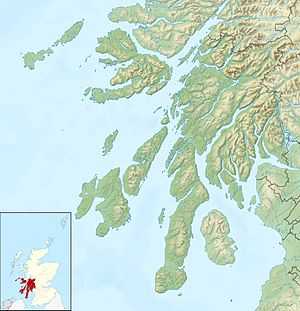Texa
| Location | |
|---|---|
 Texa Texa shown within Argyll and Bute | |
| OS grid reference | NR392437 |
| Names | |
| Gaelic name | Teacsa |
| Meaning of name | Unknown. |
| Physical geography | |
| Island group | Islay |
| Area | 48 hectares (0.19 sq mi) |
| Area rank | 207 [1] |
| Highest elevation | Ceann Garbh 48 metres (157 ft) |
| Political geography | |
| Sovereign state | United Kingdom |
| Country | Scotland |
| Council area | Argyll and Bute |
| Demographics | |
| Population | 0 |
| References | [2][3][4][5] |
Texa (Scottish Gaelic: Teacsa) is a small island 700 metres (0.4 mi) directly south of Islay, in the Inner Hebrides, Scotland. It reaches a height of 48 metres (157 ft) at its highest point, Ceann Garbh. It is part of the parish of Kildalton on Islay. The distilleries of Laphroaig and Lagavulin are nearby on the Islay coast, as well as Port Ellen. It is currently uninhabited, but is home to wild goats, as well as otters.

Geology
The island has its own fresh water supply at Tobar Moireig. The rock is mainly schist and some hornblende.
History
Church history
Texa has tentatively been identified as the Oidecha Insula written about by St Adomnan. The etymology of the name is disputed – it may represent either the Old Irish tech (house – taigh in modern Scottish Gaelic) or Oideachd/Oideachas, a word for a religious seminary.
Adomnan mentions that St Cainneach (Kenneth) used "Oidecha Insula" as a stopping place on his journey between Iona and Ireland. Kenneth is said to have left his crozier on Iona on this journey, so St Columba blessed it, cast it into the sea, and it washed up on Oidecha where Kenneth found it.
Miscellaneous

In the 13th Century, the Norse fleet of Somerled anchored near to Texa. Islay was one of the centres of Norse culture in the Hebrides.
The island's name has been recorded in a number of variants. In 1385, John of Fordun refers to Texa as "Helan ttexa" ("eilean" being an island in Gaelic). In 1549, Dean Monro wrote of "Tisgay" that it was: "callit by the Erische Tisgay, ane myle of lenthe guid maineland, and ane kirk in it; very guid it is for sheep and for fishing."[6]
In 1614, it was referred to in a document as "Ilantasson", and was chartered by the crown to Sir John Campbell of Cawdor, confirmed by a Scottish Act of Parliament in 1626. In 1608, Andrew Knox, bishop of the Isles, wrote from "Ilintexa". In 1625, Father Cornelius Ward, a Franciscan missionary reported that there were twenty nine people living on the island, and most of them were Roman Catholic. (The island was inhabited until the early 19th century.) The six who were not Catholic, he converted. Johan Blaeu's 1654 Atlas records Texa as "Ylen Teghza".
The Statistical Account, written more than a century and a half later, records that:[7]
There is good pasture on this small island; and there is a burying-place around the chapel the walls of which are partly standing. There are the remains of other 2 or 3 chapels in this parish, where they were formerly wont to bury those who were of the popish religion; but the whole inhabitants of this parish now belong to the Established Church.
Footnotes
- ↑ Area and population ranks: there are c. 300 islands >20ha in extent and 93 permanently inhabited islands were listed in the 2011 census.
- ↑ 2001 UK Census per List of islands of Scotland
- ↑ Ordnance Survey
- ↑ Haswell-Smith, Hamish (2004). The Scottish Islands. Edinburgh: Canongate. ISBN 978-1-84195-454-7.
- ↑ http://www.scottish.parliament.uk/vli/language/gaelic/pdfs/placenamesP-Z.pdf
- ↑ Monro (1549) "Tisgay" no. 65
- ↑ Robertson, Rev. Mr. Archibald Statistical Account (1791-99) vol. XI "Parish of Kildalton: County of Argyle" p. 290
References
- Statistical Account (1791-99) University of Edinburgh: University of Glasgow.
- Monro, Sir Donald (1549) Description of the Western Isles of Scotland. William Auld. Edinburgh - 1774 edition.
Coordinates: 55°37′N 6°8.5′W / 55.617°N 6.1417°W
| ||||||||||||||||||||||||||||||||||||||||||